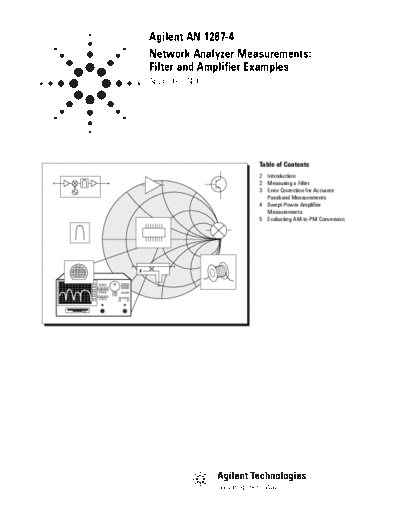Service Manuals, User Guides, Schematic Diagrams or docs for : HP Publikacje 5965-7710E
<< Back | HomeMost service manuals and schematics are PDF files, so You will need Adobre Acrobat Reader to view : Acrobat Download Some of the files are DjVu format. Readers and resources available here : DjVu Resources
For the compressed files, most common are zip and rar. Please, extract files with Your favorite compression software ( WinZip, WinRAR ... ) before viewing. If a document has multiple parts, You should download all, before extracting.
Good luck. Repair on Your own risk. Make sure You know what You are doing.
Image preview - the first page of the document

>> Download 5965-7710E documenatation <<
Text preview - extract from the document
Agilent AN 1287-4
Network Analyzer Measurements:
Filter and Amplifier Examples
Application Note
Table of Contents
2 Introduction
2 Measuring a Filter
3 Error Correction for Accurate
Passband Measurements
4 Swept-Power Amplifier
Measurements
5 Evaluating AM-to-PM Conversion
Introduction
The network analyzer is used for a variety of device and component charac-
terization tasks in both laboratory and production environments. This highly
accurate instrument can evaluate both active and passive components for
measurements of a filter and amplifier, as will be demonstrated in this applica-
tion note. With the addition of time-domain capability, a network analyzer
can also gate out unwanted responses during measurements, leaving only the
desired information.
Agilent Technologies offers a wide range of RF and microwave network analyz-
ers for measurements from DC to 110 GHz. These instruments are available
with a wide range of options and test sets to simplify measurements in stand-
alone and automatic-test-equipment (ATE) setups.
Often, both the magnitude and phase behavior of a component can be critical
to the performance of a communications system. A vector network analyzer
can provide information on a wide range of these devices, from active devices
such as amplifiers and transistors, to passive devices such as capacitors and
filters. This application note illustrates swept-frequency measurements on an
RF filter, and swept-power measurements on a communications-band amplifier.
The amplifier is typical of those used in Global System for Mobile Commun-
ications (GSM) service.
Measuring a Filter
Complete characterization of filters is typically achieved with swept-frequency
measurements. Shown in Figure 1 are the frequency responses of a filter. On
the left and bottom we see the transmission response in log magnitude format,
and on the right we see the reflection response (return loss).
The most commonly measured filter characteristics are insertion loss and
bandwidth, shown on the lower plot with an expanded vertical scale. Another
common measured parameter is out-of-band rejection. This is a measure of
how well a filter passes signals within its bandwidth while simultaneously
rejecting signals well outside that same bandwidth. A test system's dynamic
range generally determines how well it can evaluate this characteristic.
CH1S11 log MAG 5 dB/ REF 0 dB
CH1S21 log MAG 10 dB/ REF 0 dB
Cor
Stopband
69.1 dB rejection
CENTER 200.000 MHz SPAN 50.000 MHz
START .300 000 MHz
CH1 S21 log MAG
STOP 400.000 000 MHz 1 dB/ REF 0 dB
Return loss
Cor
1
m1: 4.000 000 GHz -0.16 dB
m2-ref: 2.145 234 GHz 0.00 dB
2
Insertion loss ref
Cor
x2 1 2
START 2 000.000 MHz STOP 6 000.000 MHz
Figure 1. Testing Filters with Frequency Sweeps
2
The return loss plot is typical of passive reflective filters, showing high reflec-
tion (near 0 dB) in the stopbands, and good impedance matching in the pass-
band. A different type of filter, known as an absorptive filter, tends to be well
matched in both the stopband and passband, providing a good match over a
broad frequency range.
Error Correction for Accurate Passband Measurements
Variation from a constant amplitude response within the filter's bandwidth
results in signal distortion. Error correction is often essential for accurate
measurements of filter passbands. When a filter's passband is measured with
a network analyzer without calibration, the response may vary considerably,
depending on the network analyzer and test cables used (Figure 2).
When the same filter is evaluated after doing a response calibration (normal-
ization), the test system's transmission-tracking frequency-response error is
removed from the measured response, resulting in a much narrower amplitude-
distortion window. After normalization, the filter's displayed frequency
response still shows some amplitude ripple caused by interaction between the
test system's source and load match. This ripple even goes above the 0 dB
reference line, indicating gain (which is impossible since passive devices can-
not amplify signals). This apparent anomaly is due to mismatch measurement
error. By performing a two-port calibration prior to the filter measurement,
these errors are removed.
Following vector-error correction (two-port calibration), it is apparent that the
filter's passband amplitude response varies by only ◦ Jabse Service Manual Search 2024 ◦ Jabse Pravopis ◦ onTap.bg ◦ Other service manual resources online : Fixya ◦ eServiceinfo